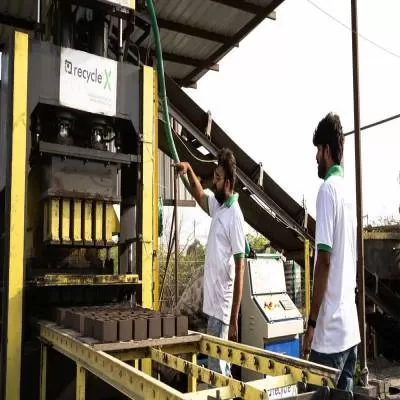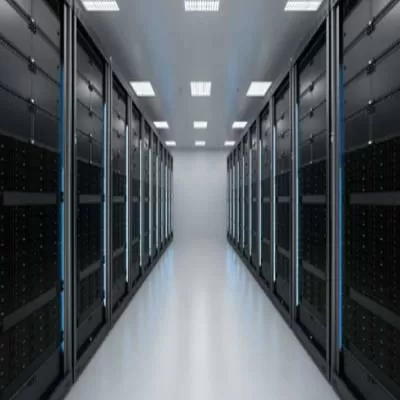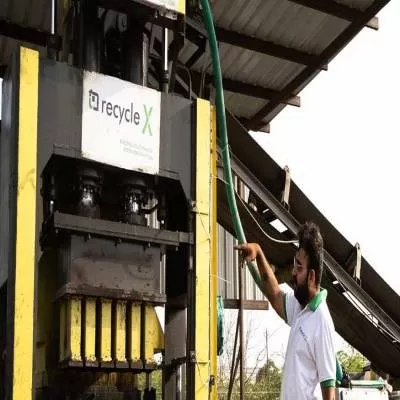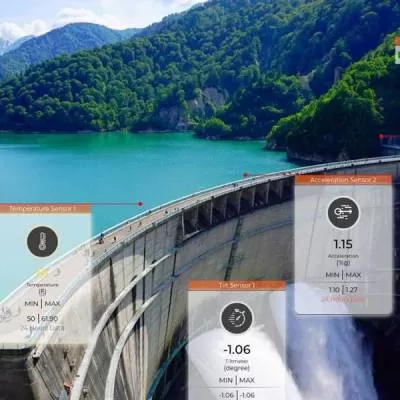- Home
- Technology
- The Magic Mineral

The Magic Mineral
Gypsum is a rocklike mineral commonly found in the earth´s crust, extracted, processed and used in construction or decoration in the form of plaster and alabaster. In fact, gypsum has been used in construction since the days of ancient Egypt, where it was used in building the pyramids. Some of this construction is still visible over 5,000 years later, a tribute to gypsum´s durability as a building material.
Amitesh Agrawal, Director-Marketing, India Gypsum Pvt Ltd, a company that manufactures gypsum products, shares more on the material and its advantages in the building and construction space.
Going back in time
Gypsum is a sedimentary mineral. It was found in layers that were formed under salt water millions of years ago; the water evaporated and left the mineral. Gypsum is an abundant mineral and takes forms including alabaster - a material used in decoration and construction as far back as ancient Egypt. Some of this construction is still visible over 5,000 years later, a tribute to gypsum´s durability as a building material. The White Sands National Monument in New Mexico is the world´s largest gypsum dune field. In the 20th century, the demand for rapid construction of military housing, brought about by World War I, led to a sharp increase in the demand for gypsum board.
After a barracks fire tragically took the lives of several servicemen, gypsum board´s fire-resistant qualities made it a preferred choice in military housing.
What´s in the make?
Gypsum is composed of calcium sulphate (CaSO4) and water (H2O), ie, Calcium Sulphate Dihydrate (CaSO4.2H2O). Chemically known as ´calcium sulphate dihydrate´, gypsum contains calcium, sulphur bound to oxygen, and water. This non-toxic mineral can be helpful to humans, animals, plant life, and the environment, while the majority of gypsum produced is used to manufacture gypsum board or building plasters.
What is gypsum board?
Gypsum board is commonly known as drywall. Gypsum Board Installation is the technical product name used by manufacturers for a specific board with a gypsum core and a paper facing. Gypsum board is the premier building material for wall, ceiling, and partition systems in residential, institutional, and commercial structures and is designed to provide a monolithic surface when joints and fastener heads are covered with a joint treatment system.
Manufacturing the board
To produce gypsum board, calcined gypsum is mixed with water and additives to form slurry that is fed between continuous layers of paper on a board machine. As the board moves down a conveyer line, the calcium sulphate re-crystallises or rehydrates, reverting to its original rock state. The paper becomes chemically and mechanically bonded to the core. The board is then cut to length and conveyed through dryers to remove any free moisture. Internationally, ASTM is the leading standard that governs the manufacture of gypsum board and sets strict criteria for strength, water resistance, and other characteristics. In India, it is IS:2095 standards for gypsum boards.
Outstanding benefits
One principal advantage of gypsum board over plywood, hardboard, and fibreboard is its strong fire resistance. Besides this, gypsum board walls and ceilings have a number of outstanding advantages, which include ease of installation, sound isolation, durability, economy and versatility. Gypsum products also provide these benefits along with quality and convenience.
Reasonable and recyclable
Gypsum-based false ceiling and partition work costs about Rs 50-90 per sq ft, depending on the interior design. Gypsum is also an indefinitely recyclable raw material. It can always be reused because the chemical composition of the raw material in the products remains unchanged. Gypsum products can further be counted among the few construction materials where closed-loop recycling is possible, ie, where the waste is used to make the same product again.
Solution builder
Gypsum has outstanding insulation properties and can offer good attributes such as fire protection, moisture resistance and impact resistance when used in combination with the correct installation systems. Conventionally, in India, sand, wood and water form the base of every building material. The quantity of sand, water and wood that goes into constructing a structure, if calculated, gives a huge amount that can otherwise be utilised for a more efficient environment-friendly purpose. With the need to adapt to more environment-friendly ways of construction to preserve and use natural resources optimally, gypsum is the natural preferred option for Indians. Gypsum products have been used for decades in the construction space, and it is the material of choice because of its inimitable properties such as good insulation (thermal and acoustic), passive fire protection, moisture resistance and impact resistance.
Lighter and faster to build
Drywalls are used for interior partitioning from a practical as well as aesthetic point of view. Drywalls, as the name suggests, is a dry construction technique to build walls that are lighter and faster to construct. A strong and durable drywall consists of a IGPL framework (studs, floor and ceiling channels) fixed to IGPL gypsum plasterboards on both the face sides. The same is then finished using a joining compound and paper tapes for a monolithic finish. Between the metal stud partitions is an air gap that can be filled with glass wool insulation to get higher fire and acoustic performance ratings. Drywalls have been demonstrated to be more effective and environment-friendly than conventional wood and sand in the building process. Various kinds of gypsum plasterboards are used based on end application needs in terms of performance like IGPL Fire Resistant for fire applications, IGPL Moisture Resistant for high moisture areas, etc. Being a green, recyclable material, gypsum ensures a smoother and well-timed finish, higher output, and higher performance. In addition, it does not pollute the construction site in any significant way.
Growing usage
Gypsum has served as a vital piece of many famous construction projects throughout history.
Over thousands of years, this important mineral has demonstrated its versatility and sturdiness and has become a staple in today´s homes, buildings and structures. In India, too, IGPL gypsum plasters have played a major role in green buildings by replacing replaced sand-cement plasters as the solution of choice for leading builders. The knowledge and use of gypsum in India is steadily growing day by day; its cost is also nominal. Thus, its use is increasing manifold across sectors such as ITeS, hospitality, institutions and government projects. However, there is still a need to communicate its use and advantages prominently.
From the eye of the User
BIL Infratech Ltd has been using Gypsum for the past three-to-four years. R Roy, General Manager, BIL Infratech Ltd, shares his experience on using Gypsum, from a user´s perspective.
¨It is cost-effective,¨ says Roy, further adding that the quality of the material is good and helps in timely delivery of projects. Along with timely completion, it also helps in reducing cost overrun. In addition, the percentage of wastage of the material is comparatively less. ¨The materials that would be used in place of this, if any, would be comparatively costly and are not readily available.¨ Further, it can also serve as a replacement to other construction and building materials, shares Roy, such as false ceiling material, particle boards, cement fibre boards, mineral fibre boards, etc.
- Seraphina D´souza
To share your experience and insights on an interesting construction material, write in at feedback@ConstructionWord.in
With a strong fire-resistant property, gypsum is a premier building material and is gaining popularity in India. Gypsum is a rocklike mineral commonly found in the earth´s crust, extracted, processed and used in construction or decoration in the form of plaster and alabaster. In fact, gypsum has been used in construction since the days of ancient Egypt, where it was used in building the pyramids. Some of this construction is still visible over 5,000 years later, a tribute to gypsum´s durability as a building material. Amitesh Agrawal, Director-Marketing, India Gypsum Pvt Ltd, a company that manufactures gypsum products, shares more on the material and its advantages in the building and construction space. Going back in time Gypsum is a sedimentary mineral. It was found in layers that were formed under salt water millions of years ago; the water evaporated and left the mineral. Gypsum is an abundant mineral and takes forms including alabaster - a material used in decoration and construction as far back as ancient Egypt. Some of this construction is still visible over 5,000 years later, a tribute to gypsum´s durability as a building material. The White Sands National Monument in New Mexico is the world´s largest gypsum dune field. In the 20th century, the demand for rapid construction of military housing, brought about by World War I, led to a sharp increase in the demand for gypsum board. After a barracks fire tragically took the lives of several servicemen, gypsum board´s fire-resistant qualities made it a preferred choice in military housing. What´s in the make? Gypsum is composed of calcium sulphate (CaSO4) and water (H2O), ie, Calcium Sulphate Dihydrate (CaSO4.2H2O). Chemically known as ´calcium sulphate dihydrate´, gypsum contains calcium, sulphur bound to oxygen, and water. This non-toxic mineral can be helpful to humans, animals, plant life, and the environment, while the majority of gypsum produced is used to manufacture gypsum board or building plasters. What is gypsum board? Gypsum board is commonly known as drywall. Gypsum Board Installation is the technical product name used by manufacturers for a specific board with a gypsum core and a paper facing. Gypsum board is the premier building material for wall, ceiling, and partition systems in residential, institutional, and commercial structures and is designed to provide a monolithic surface when joints and fastener heads are covered with a joint treatment system. Manufacturing the board To produce gypsum board, calcined gypsum is mixed with water and additives to form slurry that is fed between continuous layers of paper on a board machine. As the board moves down a conveyer line, the calcium sulphate re-crystallises or rehydrates, reverting to its original rock state. The paper becomes chemically and mechanically bonded to the core. The board is then cut to length and conveyed through dryers to remove any free moisture. Internationally, ASTM is the leading standard that governs the manufacture of gypsum board and sets strict criteria for strength, water resistance, and other characteristics. In India, it is IS:2095 standards for gypsum boards. Outstanding benefits One principal advantage of gypsum board over plywood, hardboard, and fibreboard is its strong fire resistance. Besides this, gypsum board walls and ceilings have a number of outstanding advantages, which include ease of installation, sound isolation, durability, economy and versatility. Gypsum products also provide these benefits along with quality and convenience. Reasonable and recyclable Gypsum-based false ceiling and partition work costs about Rs 50-90 per sq ft, depending on the interior design. Gypsum is also an indefinitely recyclable raw material. It can always be reused because the chemical composition of the raw material in the products remains unchanged. Gypsum products can further be counted among the few construction materials where closed-loop recycling is possible, ie, where the waste is used to make the same product again. Solution builder Gypsum has outstanding insulation properties and can offer good attributes such as fire protection, moisture resistance and impact resistance when used in combination with the correct installation systems. Conventionally, in India, sand, wood and water form the base of every building material. The quantity of sand, water and wood that goes into constructing a structure, if calculated, gives a huge amount that can otherwise be utilised for a more efficient environment-friendly purpose. With the need to adapt to more environment-friendly ways of construction to preserve and use natural resources optimally, gypsum is the natural preferred option for Indians. Gypsum products have been used for decades in the construction space, and it is the material of choice because of its inimitable properties such as good insulation (thermal and acoustic), passive fire protection, moisture resistance and impact resistance. Lighter and faster to build Drywalls are used for interior partitioning from a practical as well as aesthetic point of view. Drywalls, as the name suggests, is a dry construction technique to build walls that are lighter and faster to construct. A strong and durable drywall consists of a IGPL framework (studs, floor and ceiling channels) fixed to IGPL gypsum plasterboards on both the face sides. The same is then finished using a joining compound and paper tapes for a monolithic finish. Between the metal stud partitions is an air gap that can be filled with glass wool insulation to get higher fire and acoustic performance ratings. Drywalls have been demonstrated to be more effective and environment-friendly than conventional wood and sand in the building process. Various kinds of gypsum plasterboards are used based on end application needs in terms of performance like IGPL Fire Resistant for fire applications, IGPL Moisture Resistant for high moisture areas, etc. Being a green, recyclable material, gypsum ensures a smoother and well-timed finish, higher output, and higher performance. In addition, it does not pollute the construction site in any significant way. Growing usage Gypsum has served as a vital piece of many famous construction projects throughout history. Over thousands of years, this important mineral has demonstrated its versatility and sturdiness and has become a staple in today´s homes, buildings and structures. In India, too, IGPL gypsum plasters have played a major role in green buildings by replacing replaced sand-cement plasters as the solution of choice for leading builders. The knowledge and use of gypsum in India is steadily growing day by day; its cost is also nominal. Thus, its use is increasing manifold across sectors such as ITeS, hospitality, institutions and government projects. However, there is still a need to communicate its use and advantages prominently. From the eye of the User BIL Infratech Ltd has been using Gypsum for the past three-to-four years. R Roy, General Manager, BIL Infratech Ltd, shares his experience on using Gypsum, from a user´s perspective. ¨It is cost-effective,¨ says Roy, further adding that the quality of the material is good and helps in timely delivery of projects. Along with timely completion, it also helps in reducing cost overrun. In addition, the percentage of wastage of the material is comparatively less. ¨The materials that would be used in place of this, if any, would be comparatively costly and are not readily available.¨ Further, it can also serve as a replacement to other construction and building materials, shares Roy, such as false ceiling material, particle boards, cement fibre boards, mineral fibre boards, etc. - Seraphina D´souza To share your experience and insights on an interesting construction material, write in at feedback@ConstructionWord.in























